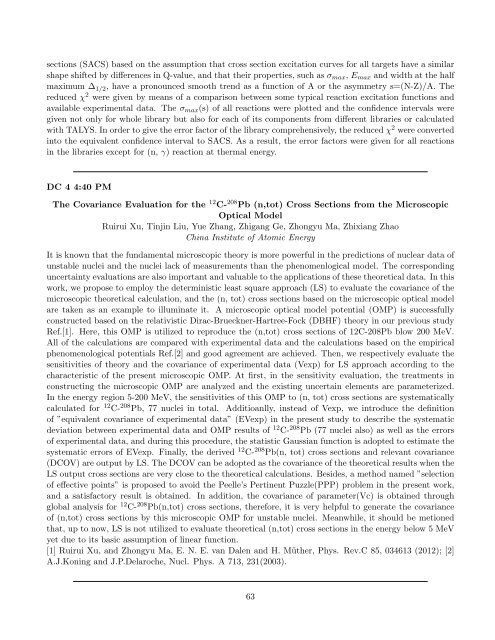Program - Brookhaven National Laboratory
Program - Brookhaven National Laboratory
Program - Brookhaven National Laboratory
You also want an ePaper? Increase the reach of your titles
YUMPU automatically turns print PDFs into web optimized ePapers that Google loves.
sections (SACS) based on the assumption that cross section excitation curves for all targets have a similar<br />
shape shifted by differences in Q-value, and that their properties, such as σmax, Emax and width at the half<br />
maximum ∆ 1/2, have a pronounced smooth trend as a function of A or the asymmetry s=(N-Z)/A. The<br />
reduced χ 2 were given by means of a comparison between some typical reaction excitation functions and<br />
available experimental data. The σmax(s) of all reactions were plotted and the confidence intervals were<br />
given not only for whole library but also for each of its components from different libraries or calculated<br />
with TALYS. In order to give the error factor of the library comprehensively, the reduced χ 2 were converted<br />
into the equivalent confidence interval to SACS. As a result, the error factors were given for all reactions<br />
in the libraries except for (n, γ) reaction at thermal energy.<br />
DC 4 4:40 PM<br />
The Covariance Evaluation for the 12 C- 208 Pb (n,tot) Cross Sections from the Microscopic<br />
Optical Model<br />
Ruirui Xu, Tinjin Liu, Yue Zhang, Zhigang Ge, Zhongyu Ma, Zhixiang Zhao<br />
China Institute of Atomic Energy<br />
It is known that the fundamental microscopic theory is more powerful in the predictions of nuclear data of<br />
unstable nuclei and the nuclei lack of measurements than the phenomenlogical model. The corresponding<br />
uncertainty evaluations are also important and valuable to the applications of these theoretical data. In this<br />
work, we propose to employ the deterministic least square approach (LS) to evaluate the covariance of the<br />
microscopic theoretical calculation, and the (n, tot) cross sections based on the microscopic optical model<br />
are taken as an example to illuminate it. A microscopic optical model potential (OMP) is successfully<br />
constructed based on the relativistic Dirac-Brueckner-Hartree-Fock (DBHF) theory in our previous study<br />
Ref.[1]. Here, this OMP is utilized to reproduce the (n,tot) cross sections of 12C-208Pb blow 200 MeV.<br />
All of the calculations are compared with experimental data and the calculations based on the empirical<br />
phenomenological potentials Ref.[2] and good agreement are achieved. Then, we respectively evaluate the<br />
sensitivities of theory and the covariance of experimental data (Vexp) for LS approach according to the<br />
characteristic of the present microscopic OMP. At first, in the sensitivity evaluation, the treatments in<br />
constructing the microscopic OMP are analyzed and the existing uncertain elements are parameterized.<br />
In the energy region 5-200 MeV, the sensitivities of this OMP to (n, tot) cross sections are systematically<br />
calculated for 12 C- 208 Pb, 77 nuclei in total. Additioanlly, instead of Vexp, we introduce the definition<br />
of ”equivalent covariance of experimental data” (EVexp) in the present study to describe the systematic<br />
deviation between experimental data and OMP results of 12 C- 208 Pb (77 nuclei also) as well as the errors<br />
of experimental data, and during this procedure, the statistic Gaussian function is adopted to estimate the<br />
systematic errors of EVexp. Finally, the derived 12 C- 208 Pb(n, tot) cross sections and relevant covariance<br />
(DCOV) are output by LS. The DCOV can be adopted as the covariance of the theoretical results when the<br />
LS output cross sections are very close to the theoretical calculations. Besides, a method named ”selection<br />
of effective points” is proposed to avoid the Peelle’s Pertinent Puzzle(PPP) problem in the present work,<br />
and a satisfactory result is obtained. In addition, the covariance of parameter(Vc) is obtained through<br />
global analysis for 12 C- 208 Pb(n,tot) cross sections, therefore, it is very helpful to generate the covariance<br />
of (n,tot) cross sections by this microscopic OMP for unstable nuclei. Meanwhile, it should be metioned<br />
that, up to now, LS is not utilized to evaluate theoretical (n,tot) cross sections in the energy below 5 MeV<br />
yet due to its basic assumption of linear function.<br />
[1] Ruirui Xu, and Zhongyu Ma, E. N. E. van Dalen and H. Müther, Phys. Rev.C 85, 034613 (2012); [2]<br />
A.J.Koning and J.P.Delaroche, Nucl. Phys. A 713, 231(2003).<br />
63
















